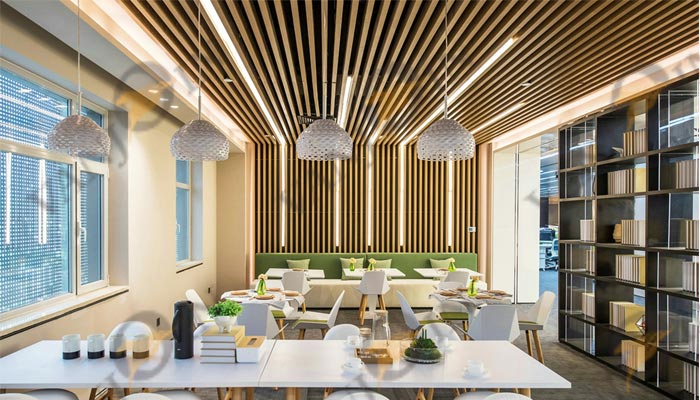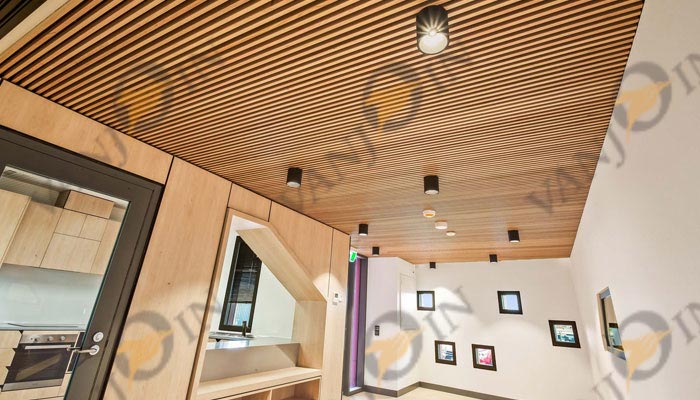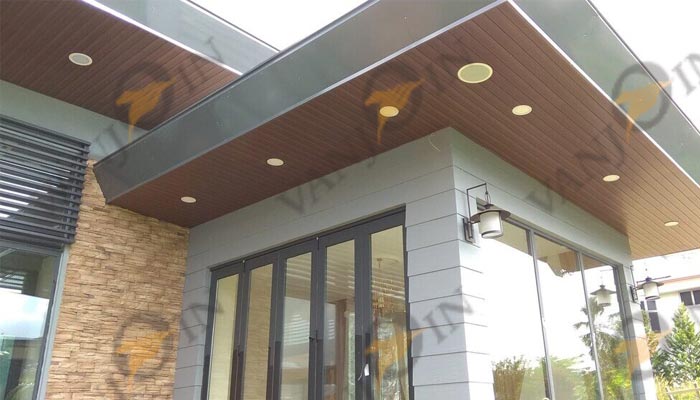Welcome to VANJOIN. Your satisfaction is our biggest pursuit.
Interior design is an ever-changing and creative field. In order to change the appearance of a living area, people often look for new materials. In the search for new ideas, we have found a great answer: the WPC ceiling. If you’re interested in beautiful ceilings in modern homes and businesses, you’ve probably come across this interesting term. But what is the WPC ceiling? Why is it so popular in home decor?
What is WPC Material?
WPC material stands for “wood-plastic composite,” and it’s popular because of its versatility, durability, and beauty. It is made from a blend of natural wood fibers and recyclables. This makes it a material that combines the best of both worlds. For architects, interior designers, and homeowners, this new composite material opens up endless possibilities. It has revolutionized the way ceilings are planned and decorated.
In this complete guide, we will embark on a journey to discover everything there is to know about WPC ceilings. Without a doubt, we will do our best to take a comprehensive look at WPC ceilings, from their complex composition to their amazing properties.
We’ll also discuss the many ways in which WPC interior ceilings can be used, showing how they can easily improve the ambiance of any room. Whether you’re a designer looking for new ideas or a homeowner looking to decorate your home, we hope this exploration of WPC ceilings will inspire you.

What Materials Wood Plastic Ceilings Are Made Of
Before we go into detail about the features of wood-plastic ceilings, let’s take a look at what WPC ceilings are made of. Wood plastic ceilings are a hybrid material, which means it has the classic beauty of wood and the modern wonder of plastic.
Wood Fiber
WPC materials contain a certain composition of wood fibers. These fibers, often made from recycled or salvaged wood, add to the natural look of the ceiling. The wood component gives the WPC material a warm and authentic feel, making it look and feel like real wood.
Recyclable Plastic
The addition of recyclable plastics gives WPC materials a longer, more resilient life. Plastic components make WPC decorative products strong and protect them from damage and weather. They also give WPC products excellent water resistance, a problem with many traditional wood products.
Additives and Adhesives
During the manufacturing process, adhesives are used to hold the wood fibers and plastic particles together. These chemicals also make WPC products more stable. You can add substances such as UV inhibitors and colorants to protect WPC from sunlight and offer a wide range of colors to choose from.
Extrusion Process
The extrusion method is used to manufacture WPC ceilings. In this method, a mixture of wood fibers, recyclable plastics, adhesives, and additives is heated and passed through a mold. This process ensures that the shape and texture of the material is perfectly consistent and makes it strong and durable.
The end result is a WPC material that has the classic beauty of wood and the durability and strength of modern plastics. But the magic doesn’t stop there: WPC ceilings are unique not only for their material but also for their functionality.

Advantages of WPC Ceiling Panels
Now that we know how wood-plastic ceilings are made, let’s take a look at why these ceilings are an interior designer’s dream. While WPC ceilings are very versatile, they can be used for many different purposes.
Superior Aesthetics
One thing that makes WPC ceiling panels stand out is that they look great. These products can make things look as stunning as solid wood. Whether you want the natural beauty of oak, the elegance of cherry, or the smoothness of maple, WPC ceilings have you covered.
Because there are so many styles and colors to choose from, you can get creative with the design and make your ceiling a work of art.
Durable
Although they look like wood, WPC ceiling panels are much stronger. Because they contain a polymer component, they are less likely to absorb water. This makes them ideal for use in places where regular wood would get moldy or rot. They are also less prone to scratches or dents, so they stay beautiful even in high-traffic areas.
Easy to Maintain
While natural wood requires regular maintenance and sealing, WPC ceiling panels don’t require much maintenance. Often all that is needed is a wipe with a damp cloth to keep it looking brand new. This ease of use not only saves time but also reduces the cost of long-term maintenance.
Environmentally Friendly
If you are environmentally conscious, WPC ceiling panels are a good choice. Because they are made from recycled wood fibers and recyclable plastics, they help protect forests and the environment.
In addition, these ceilings don’t need to be replaced as often because they last a long time and don’t require much maintenance. This makes them even better for the environment.
Wide Range of Applications
WPC ceiling panels can be used in places other than the home. Because they can be used in so many different places, they are perfect for use in businesses, offices, restaurants, and even outdoors.
Whether you are remodeling a cozy home or renovating the lobby of a luxury hotel, WPC ceilings can improve the atmosphere.
Easy to Install
Installing WPC ceilings is very simple. Many times, they come with a simple locking structural system. This makes them simple to install without the need for any complicated tools or specialized personnel. This not only reduces construction costs but also saves time.

Comparing Different Types of Ceilings
While WPC ceiling panels are one type of ceiling material, they are by no means the only one. They compete with many other types of materials, each with their own pros and cons. Let’s take a look at how WPC ceilings compare to some other popular options.
Traditional Wood
Aesthetics: Natural wood undoubtedly gives a warm and inviting feel, but it can be susceptible to moisture and mold and requires regular maintenance.
Durability: WPC panels last longer than wood, especially in wet areas.
Cost: The price of wood ceilings fluctuates with the type of wood. While the price of the WPC ceiling has been more stable.
PVC Ceiling
Waterproofing: PVC sheets have excellent waterproofing properties, so it works well in wet environments.
Aesthetics: PVC material has an obvious plastic texture and cannot bring a natural look.
Installation: Both PVC panels and WPC panels are known for their ease of installation.
Gypsum Board Ceiling
Versatility: Gypsum board ceilings can be used in a variety of ways, but the appearance may not be as beautiful as WPC ceilings.
Durability: Not as good as WPC ceilings in terms of durability and moisture resistance.
Customizability: WPC ceiling panels offer customization, which gives designers more options.
Metal Ceilings
Modern look: Metal ceilings have a clean, modern look, but may not suit all design ideas.
Durability: Metal materials are very durable.
Sound absorption: WPC ceiling panels provide better noise blockage compared to metal.
WPC ceiling panels can make your space look better. It’s clear that WPC ceilings are the perfect combination of form and function, which not only embraces the classic beauty of wood but also smoothly solves the problems that nature and time often bring to traditional materials.
Choose WPC ceiling panels not just because they’re beautiful, but because they’re durable, environmentally friendly, and practical. Whether you’re a homeowner looking to make your living space more aesthetically pleasing, an interior artist looking to wow your clients with a unique design, or a business owner looking to make the atmosphere more welcoming, WPC ceilings are a great investment.